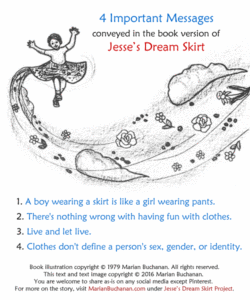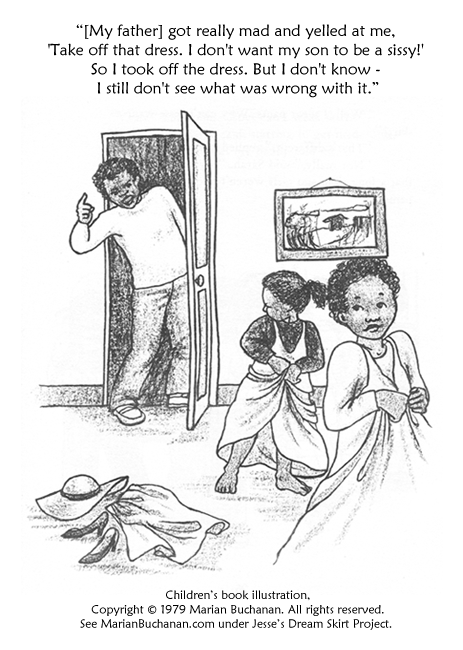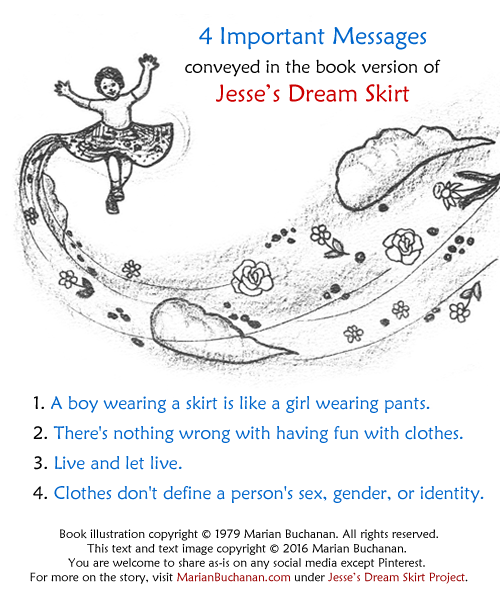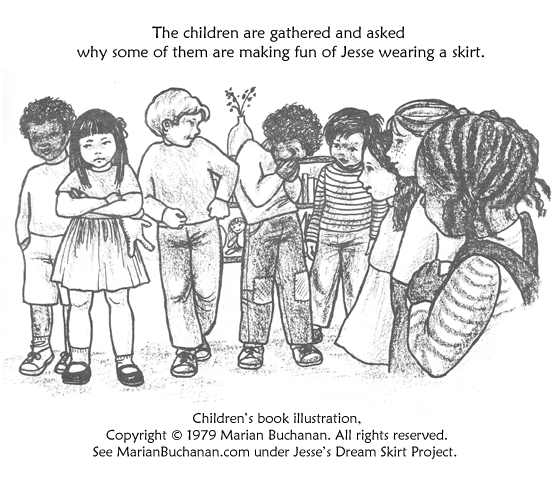Why does it matter to them that Jesse’s wearing a skirt?
 This is a continuation of the exploration started in the earlier posts in this series, and particularly the previous one about the daycare children in the Jesse’s Dream Skirt story. I mentioned there were several differences between the two versions of the story, relating to one or more of the following:
This is a continuation of the exploration started in the earlier posts in this series, and particularly the previous one about the daycare children in the Jesse’s Dream Skirt story. I mentioned there were several differences between the two versions of the story, relating to one or more of the following:
-
emotional intensity;
-
logical sequence and relevance of ideas;
-
involvement of specific children;
-
the message conveyed.
I also mentioned several stages in the children’s involvement. In this post, I explore stage #3: what message is conveyed and what arguments are made during the discussion that the teacher initiates.
In both versions of the story, the teacher goes to be with Jesse when he runs away crying. When Jesse has calmed down, the teacher whispers, “Jesse, some of us liked your skirt a whole lot, but some didn’t. Let’s find out why.” Then he calls everyone together and says, “Jesse loves his skirt. Why are some of you making fun of him?”
Making the case for the message conveyed
In the 1977 magazine version, there is a heated argument between only John and Sarah. Although it’s not explicitly pointed out, everyone else remains silent.
In the 1979 book version, we hear several more perspectives expressed, personal experiences narrated, and points made, through 3 additional children named explicitly, and possibly more at the point where everyone is talking at the same time.
In the early version, Sarah and John’s argument doesn’t make a lot of sense in terms of logical sequence of ideas. When John answers the teacher’s question (“Why are some of you making fun of him?”) by saying,”‘Cause he looks funny. I never saw a boy wear a skirt,” Sarah shouts, “But why not?” To which John snaps, “‘Cause that’s what my daddy told me.”
Huh? If we break this down semantically, it sounds like Sarah is angry that John has never seen a boy wear a skirt, and when she asks him why that is, John says it’s because that’s what his daddy told him. There’s clearly some reasoning missing here. I suspect the author knew in his head what the full reasoning was meant to be, but just forgot to spell it out in what might have been an initial draft. This is a good demonstration of the importance of securing a critical look at your manuscript by some fellow writers or an editor before publication.
Whether the author re-wrote this passage before submitting it to Lollipop Power or it was the editorial team there who requested he do so, the book version fixes the non-sequitur by attributing the initial response to Mary instead of John. In this version, she’s the one who says, “Because he looks funny. I never saw a boy wear a skirt before.” Then John contributes the missing piece of the dialogue logic, saying, “Yeah. Boys can’t wear skirts.” The flow of the dialogue continues with Sarah “starting to get mad” (she’s not actually shouting in this version) and saying, “Why not?” Now, when John answers, “Because that’s what my daddy told me,” it has something to refer back to (“Boys can’t wear skirts”), as opposed to the reader being left unsure, in the first version, what exactly it was that John’s father had told him, and in response to what.
In both versions of the story, Sarah then says, “Well, I wear pants,” and John replies, “That’s different,” to which Sarah replies, “Not really.” But where the discussion goes from there is so dissimilar between the two versions that it’s almost like two different stories.

In the early version, the lack of logical reasoning continues, as Sarah narrates how her sister was in a school where they had to wear plaid skirts and she got asked to leave for wearing pants one day. (She wore them because they were more comfortable). Sarah says the other girls then started to wear pants too. She doesn’t say whether or not this got any rules changed in the school, she just ends with, “So Jesse is brave just like my sister.”
The message conveyed seems to be about being brave for doing something no one else does, perhaps paving the way for others. It’s not what one would expect. Yes, it touches on the arbitrary nature of rules about clothing, but it’s not a logical segue to the initial point that a boy wearing a skirt is like a girl wearing pants. Talking about dress codes in institutions is a bit of a tangent that misses the opportunity to make a convincing argument in favor of gender equality and acceptance of diversity in gender expression.
The book version re-writes this entire section so as to drop the tangent and make the expected segue instead, with Sarah saying, “My mother told me that a long time ago girls weren’t allowed to wear pants.” It then covers several additional points through the sharing of personal experiences and thoughts by various other children.
First, Mike tells them about a time his mother let him and his sister try on her old dresses and hats. He says it was a lot of fun, but then his father saw him and got mad, yelling, “Take off that dress. I don’t want my son to be a sissy!” But Mike still doesn’t understand what was so wrong about it.

Then John demonstrates that he hasn’t changed his mind, saying that, no matter what they say, he couldn’t wear a skirt because he wouldn’t want anyone to think he was a girl. To which Sarah replies that nobody’s asking him to wear a skirt, but he should “Just let Jesse be.”
Then it’s Dawn’s turn to share a personal experience and her reaction to it. The boys in her neighborhood say, “Are you sure you’re not a boy?” whenever she wears her baseball uniform, but her wise response to them is, “It doesn’t matter what I wear. I’m still me.”
This gets the children all talking at once. Someone voices agreement with Dawn’s perspective, someone says they’ve had a similar experience, and someone says they think Jesse’s skirt “looks sort of nice.” Jesse gets the impression that most of the children like his skirt after all, and it makes him feel good.
So, in this version, we’ve got several important points made and several opportunities to encourage an elaboration, exploration, and discussion of the issues with the children to whom the story is read:

4 Important Messages
A boy wearing a skirt is like a girl wearing pants.
The fact that it’s not socially acceptable now is no different than what it used to be like for girls. A girl wearing pants is no longer considered cross-dressing, so why should we continue to consider it cross-dressing when a boy wears a skirt? There’s nothing intrinsic about the unacceptability of an outfit for a particular gender, it’s entirely cultural.
There’s nothing wrong with having fun with clothes.
It doesn’t mean you’re effeminate, and even if it did, there’s nothing wrong with that either. The use of “sissy” as an insult is in itself an opportunity for a whole multi-threaded discussion: the devaluation of the feminine, the use of gender as a put-down, the use of a slang word to turn an otherwise neutral concept into a slur, the bullying involved in using a put-down or slur of any kind….
Live and let live.
Just because you don’t want to adopt a certain (non-violent, non-abusive) behavior yourself (whether or not it’s because you’re afraid of the reaction you might get), doesn’t mean you should object to others adopting that behavior if they wish. This is the core message of tolerance.
Clothes don’t define a person’s sex, gender, or identity.
People are not their appearance. We all remain ourselves no matter how we present. It’s not like the boys in Dawn’s story were fooled by the outfit, so why did they even bring it up? Their “issue” was fabricated, a mere excuse for perpetuating a narrow-minded view of gender and identity.
These points make the book version of Jesse’s Dream Skirt so much more powerful as a catalyst for thoughtful discussion about the way such a benign act (wearing a skirt when you’re a boy) can create such a dramatic reaction. This effort to craft the story into a more deliberate tool of critical thinking comes as no surprise when you consider the mandate of the Lollipop Power collective: “to counteract sex-stereotyped behavior and role models presented by society to young children.”
In the next post, I’ll continue the exploration of the differences between the two versions of Jesse’s Dream Skirt, with a look at the final stage of the children’s involvement. In the meantime, please feel free to contribute your thoughts on the important messages described above.

